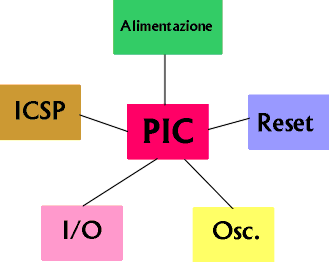|
A development and protitype board for Microchip PIC 28 & 40 pins.
A board dedicated to experimentation.
If you are experiencing circuits, is studying a function or creating a prototype with an embedded, it is used to reassemble a time each time the same
basis.
 |
In fact, the microcontroller, to operate, require a minimal amount of external components, which generally are always the
same.
They can be divided into 5 blocks:
- decoupling capacitors on power
components of external oscillator (if used)
- reset circuit (if used)
- access connections to I / O
- connector ICSP / ICD
|
It would be handy to have available ready module that supports the PIC and just add peripheral components necessary for that specific experiment or
circuit.
The design.
Here 's yet another demo board, say many.
And in fact the view of the board available for testing on the PIC is very wide because they add an
'other?
The reasons are well defined:
- Needed a board "essential", but he had the ability to be used with the broadest number of chips
- Essential means that it has no special devices on board.
- Must be practical to use and can stand alone as
- Obviously must have ICSP / ICD and simply interfaced with the debug tools from Microchip
- Must be reasonably economic
- The first point has led us to develop a card that can support both the PIC in DIP 28 pin 40 pin: a double socket means that the same basis is suitable both for one than for
others.
- The DIP package is the most suitable for experimentation and to 'education, and in fact, for all sorts of applications do not need to use 64 or 80 or 100 pin, which, being smd, or require to be soldered on the PCB, preventing the 'interchangeability, ol' use of an adapter that would boost the cost.
And, with regard to 'education,' intrecambiabilitą of many types of chips and the chance to experience so slim that the full versions is very useful. In addition, Microchip products have the 'excellent characteristic of being as far as possible, pin to pin compatible and this allows you to install on Uniboard much as 16F PIC PIC18 or 24.
One might ask why not use a chip with fewer pins, but this question does not make sense: being tested should have the maximum available resources, and then if you move to a production, it's easy to reduce everything to a smaller chip. Or to use the same, but in SMD package.
So, 28 and 40 pin, which allows the use of known 16F870, 873, 876, 877 and 18F242 and the whole family 18F in these
packages. In addition, you can also install chip 8-pin baseline.
The second point, which is derived from 'experience, says that it is rather pointless to have on the main board a sea of
devices.
Certainly not difficult to provide on the printed circuit LCD display, real time clock, serial EEPROMs, keyboards and so on. At the end you get to board also very beautiful, but very complex (and expensive) that all 'practical act is needed, but also limit so often intolerable. Especially if the devices are pre-wired connection to certain pin I / O.
Why should I use if I want or experiment or a device other than on board, I must still add externally. Even worse if I connect pins in a certain way, but the card has its own wiring, I'm stuck with that configuration only.
So, on-board LED only, oscillators and a potentiometer. Sufficient for the exercise of a course of education or for the first (and only) experiments. Then, plug connectors to connect each kind of device for which there will be realized a simple external support, a modular system as open as
possible.
The third point has led to the creation of a power supply piggy-back so that the 'only connection on the table is that between the' PC USB and development tools. No power supplies, cables and even less so no unwanted couplings, an external power supply can always be added if necessary.
And the desktop space is minimal and there are more than a few square
decimetres.
The fourth point is obvious: a power ICSP / ICD must not fail to allow an immediate connection with Pickit, Real ICE, ICD and provides both the programming on board, and, above all, the debug
functions.
Finally, in terms of a product that does not expect million pieces, a circuit double-sided metallized holes is not the right solution. And, with a reasonable study, 'Uniboard has been resolved with a single-sided that, at least, anyone can build at home.
The result is this 28-40pin Uniboard.
It is a simple solution, but not simplistic, able to compete with similar commercial products, achievable even at home, without great expense, be used in any context, fully
expandable.
The description and pictures below should dispel any doubts
|